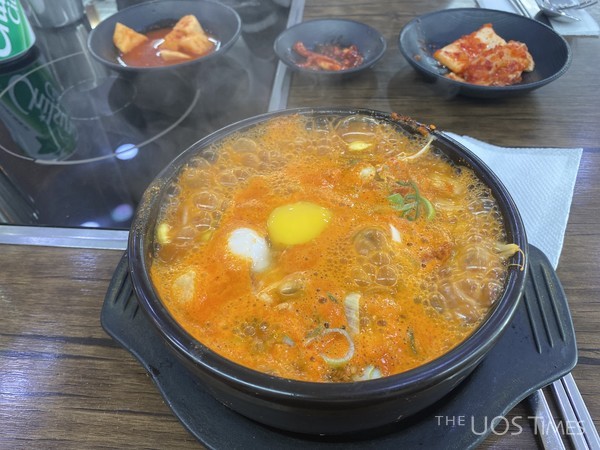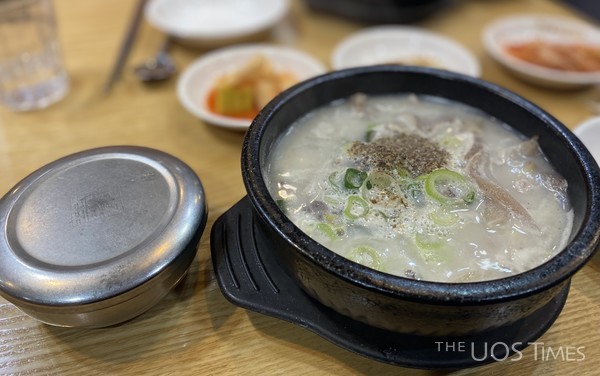Rice and soup are traditionally served separately in Korean table settings. However, gukbap is a dish that deviates from this tradition in which they are served together in a single bowl. Gukbap, which can soothe cold and hunger at an affordable price, has long been a beloved Korean dish. Depending on the local specialties, culture, and environment, a variety of gukbaps have been created nationwide, and you can enjoy a delicious and unique gukbap wherever you go.
In historical TV dramas, gukbap is usually depicted as a bowl of food sold in a jumak.[1] However, this scene could be found in the late Joseon Dynasty, when commerce began to develop. Until the middle of the Joseon Dynasty, a jumak was a place where merchants stayed and asked for alcohol. Merchants entrusted their food to the owners and asked for it to be cooked or cooked it themselves. The first record in the literature of a jumak that offered gukbap is of the “Mugyotangban,” which was frequented by Heonjong (1827–1849), the 24th king of Joseon. At that time, rice soup was served with various vegetables in a broth made out of boiled brisket and radish.
In the Japanese colonial period, gukbap began to gain popularity as a common delivery food. According to a magazine published in 1929, the owners of gukbap diners were often people of low social status, so it was not easy for those who were once aristocrats to eat it with confidence. Digging into this niche market, gukbap has been recognized as the first fast food as well as the first delivery food. Then, after Korea’s liberation from Japan and the Korean War, ever more places sold simple meals for workers, resulting in a variety of gukbap by region.
Kongnamul-gukbap[2]

The city of Jeonju is famous for its high-quality soybean sprouts, so it is no surprise that Kongnamul-gukbap is one of Jeonju’s traditional foods. Kongnamul-gukbap is a gukbap with soup and rice in soybean sprouts, as its name suggests. Soybean sprouts are abundant in protein and calcium. In particular, bean sprouts contain asparagine, an amino acid that is known to effectively aid in metabolizing alcohol. Therefore, kongnamul-gukbap made with soybean sprouts as the main ingredient is popular as a food to relieve hangovers. Kongnamul-gukbap lovers season hot gukbap with salted shrimp and add raw eggs. While kongnamul-gukbap is a popular dish in restaurants, it is among the most familiar foods for Koreans as it can be easily cooked at home. Kimchi kongnamul-gukbap with additional spicy seasoning and kimchi is also popular.
Dwaeji-gukbap[3]

Dwaeji-gukbap, a local food of Busan, is served as pork and rice in stock made from pig bones. The exact origin of dwaeji-gukbap is unknown, but it can be inferred that it originated from the age-old dish tangban.[4] Dwaeji-gukbap, which spread rapidly in the 1950s and 1960s, took root during the Korean War when evacuees invented seolleongtang[5] as a by-product of pigs, which were easy to find, instead of cow bones. The recipe of putting meat in a broth made from pig bones and adding rice was born against the background of traditional food culture and refugees, and eventually transmitted with the history of Busan. However, it developed in Miryang, Busan, and Daegu each in its own way, and now it has developed into a combination of these three methods. Dwaeji-gukbap is not only cheap but also highly nutritious, rich in such nutrients as calcium and protein, and it has become a delicious comfort food as a meal of the common people.
Sundae-gukbap

Sundae-gukbap is a dish of various pork parts and sundae in a stock made of pork bones and meat. Sundae is a type of blood sausage in Korean cuisine. It is generally made by stuffing a pig’s intestines with various ingredients; spicy seasoning, garlic chives, and powdered perilla seeds can be added to the sundae-gukbap to suit one’s taste. In the past, sundae-gukbap did not contain sundae. These days, sundae is the representative food of the common people, but in the past, it was a precious food that could only be eaten when slaughtering pigs. In addition, there are people who cannot readily eat sundae-gukbap due to the distinctive odor of pork bones and intestines, but sundae-gukbap has remained beloved until today because of its hearty serving size at a low price.
Since long ago, gukbap such as bean kongnamul-gukbap, dwaeji-gukbap, and sundae-gukbap have been the most popular go-to meals for Koreans. Also, if you eat warm gukbap after a hard day’s work, you can gain strength to live and work another day, and when you are suffering hard times, gukbap with soju warms your stomach and relieves fatigue. Let a delicious bowl of gukbap fill your empty body and soul with heartiness.
[1] In earlier kingdoms on the Korean Peninsula, jumak was the name for taverns that served alcohol and food while offering lodging to travelers.
[2] Kongnamul (soybean sprouts in English)
[3] Dwaeji (a pig, in English)
[4] Putting rice in hot soup
[5] A Korean broth made from ox bones, brisket, and other cuts

